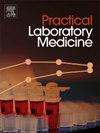基线血浆d -二聚体水平在脓毒症中的预后价值:一项前瞻性队列研究
IF 1.3
Q3 MEDICAL LABORATORY TECHNOLOGY
引用次数: 0
摘要
血浆d -二聚体是一种纤维蛋白降解产物,反映凝血激活,在危重患者中经常升高。其在脓毒症中的预后意义,特别是短期预后,尚不清楚。方法在这项前瞻性队列研究中,我们从2024年3月至2025年2月招募了175名患有脓毒症(脓毒症-3标准)的成人ICU患者。在ICU入院时和连续5天每天测量血浆d -二聚体水平。d -二聚体水平分为四分位数。主要终点为30天全因死亡率;次要结局是院内感染性休克。采用Cox回归、Kaplan-Meier分析和亚组分析分析相关性。结果入院d -二聚体水平升高与30天死亡率和感染性休克风险增加显著相关。校正混杂因素后,d -二聚体每增加1 μg/mL,死亡风险增加6% (HR = 1.06; 95% CI: 1.02-1.11; P = 0.008),感染性休克风险增加8% (HR = 1.08; 95% CI: 1.03-1.12; P < 0.001)。最高四分位数的患者预后最差。血清淀粉样蛋白A (SAA)与死亡率有显著的相互作用(P = 0.043),但与感染性休克无关。结论基线血浆d -二聚体水平可独立预测败血症患者30天死亡率和感染性休克。d -二聚体可以作为脓毒症管理风险分层的有价值的早期生物标志物。本文章由计算机程序翻译,如有差异,请以英文原文为准。
Prognostic value of baseline plasma D-dimer levels in sepsis: a prospective cohort study
Background
Plasma D-dimer, a fibrin degradation product, reflects coagulation activation and is often elevated in critically ill patients. Its prognostic significance in sepsis, particularly for short-term outcomes, remains unclear.
Methods
In this prospective cohort study, we enrolled 175 adult ICU patients with sepsis (Sepsis-3 criteria) from March 2024 to February 2025. Plasma D-dimer levels were measured at ICU admission and daily for five days. D-dimer levels were categorized into quartiles. The primary outcome was 30-day all-cause mortality; secondary outcome was in-hospital septic shock. Associations were analyzed using Cox regression, Kaplan–Meier analysis, and subgroup analysis.
Results
Elevated admission D-dimer levels were significantly associated with increased risks of 30-day mortality and septic shock. Each 1 μg/mL increase in D-dimer was linked to a 6 % higher mortality risk (HR = 1.06; 95 % CI: 1.02–1.11; P = 0.008) and an 8 % higher septic shock risk (HR = 1.08; 95 % CI: 1.03–1.12; P < 0.001), after adjusting for confounders. Patients in the highest quartile had the worst outcomes. A significant interaction with serum amyloid A (SAA) was observed for mortality (P = 0.043), but not for septic shock.
Conclusion
Baseline plasma D-dimer levels independently predict 30-day mortality and septic shock in sepsis. D-dimer may serve as a valuable early biomarker for risk stratification in sepsis management.
求助全文
通过发布文献求助,成功后即可免费获取论文全文。
去求助
来源期刊

Practical Laboratory Medicine
Health Professions-Radiological and Ultrasound Technology
CiteScore
3.50
自引率
0.00%
发文量
40
审稿时长
7 weeks
期刊介绍:
Practical Laboratory Medicine is a high-quality, peer-reviewed, international open-access journal publishing original research, new methods and critical evaluations, case reports and short papers in the fields of clinical chemistry and laboratory medicine. The objective of the journal is to provide practical information of immediate relevance to workers in clinical laboratories. The primary scope of the journal covers clinical chemistry, hematology, molecular biology and genetics relevant to laboratory medicine, microbiology, immunology, therapeutic drug monitoring and toxicology, laboratory management and informatics. We welcome papers which describe critical evaluations of biomarkers and their role in the diagnosis and treatment of clinically significant disease, validation of commercial and in-house IVD methods, method comparisons, interference reports, the development of new reagents and reference materials, reference range studies and regulatory compliance reports. Manuscripts describing the development of new methods applicable to laboratory medicine (including point-of-care testing) are particularly encouraged, even if preliminary or small scale.
 求助内容:
求助内容: 应助结果提醒方式:
应助结果提醒方式:


